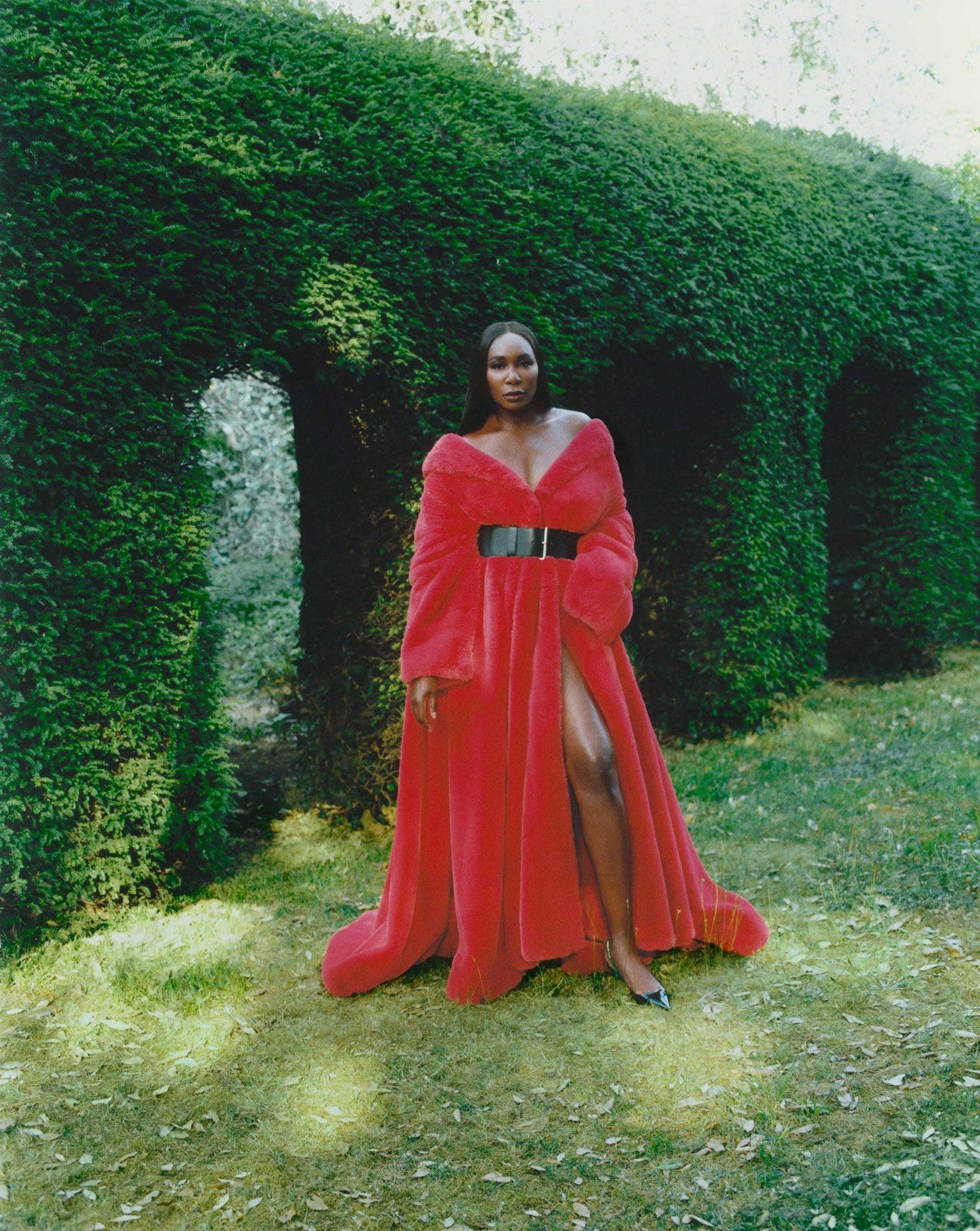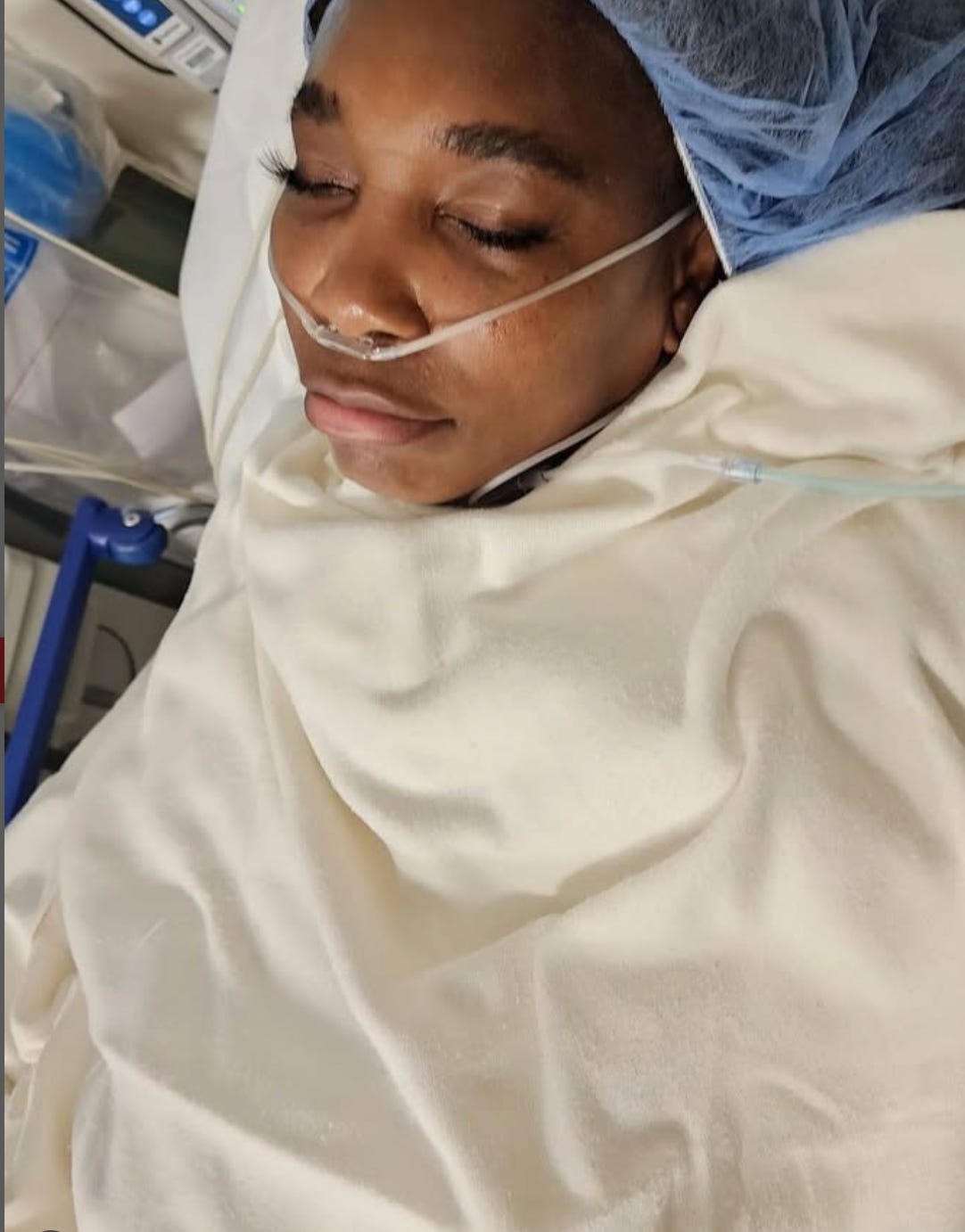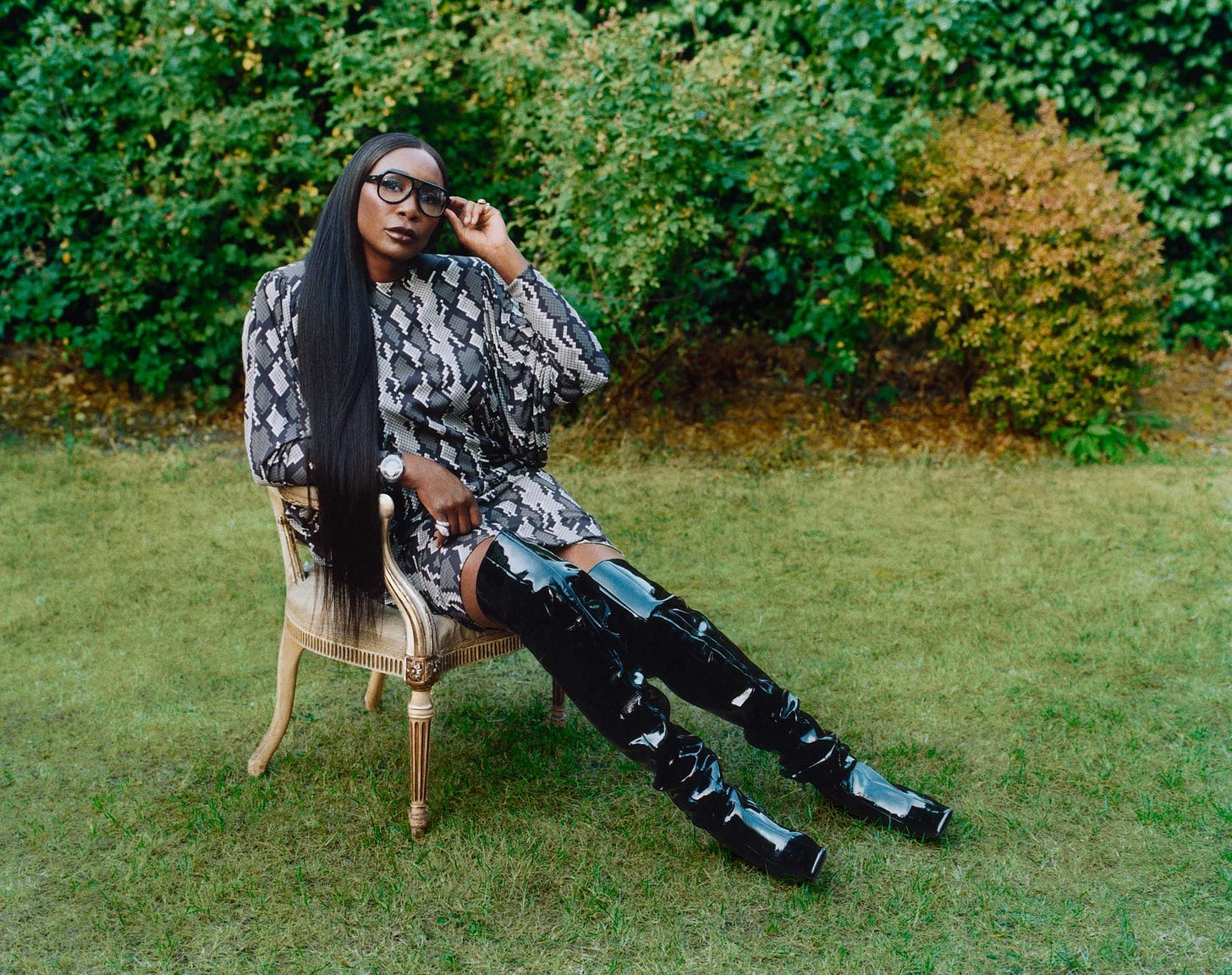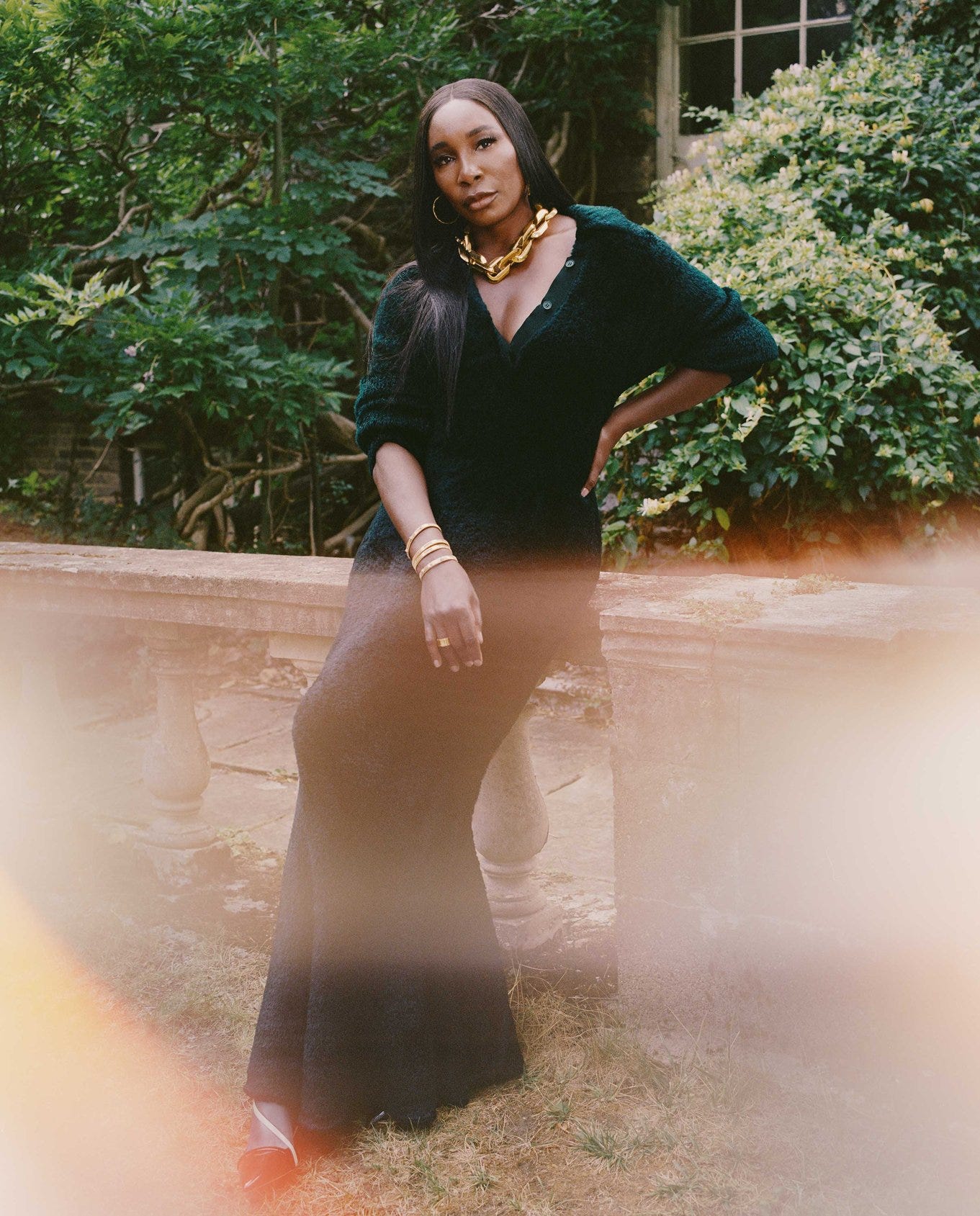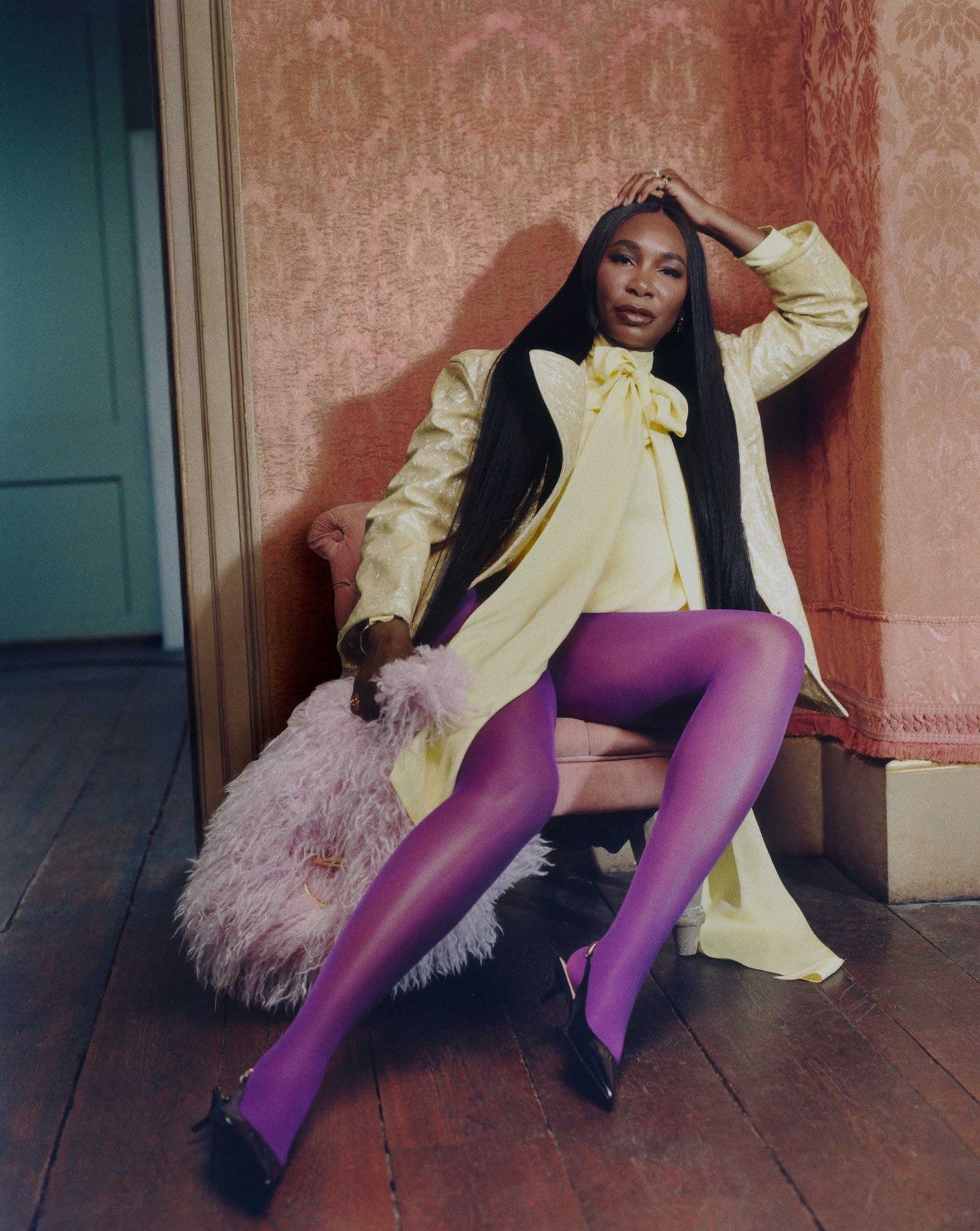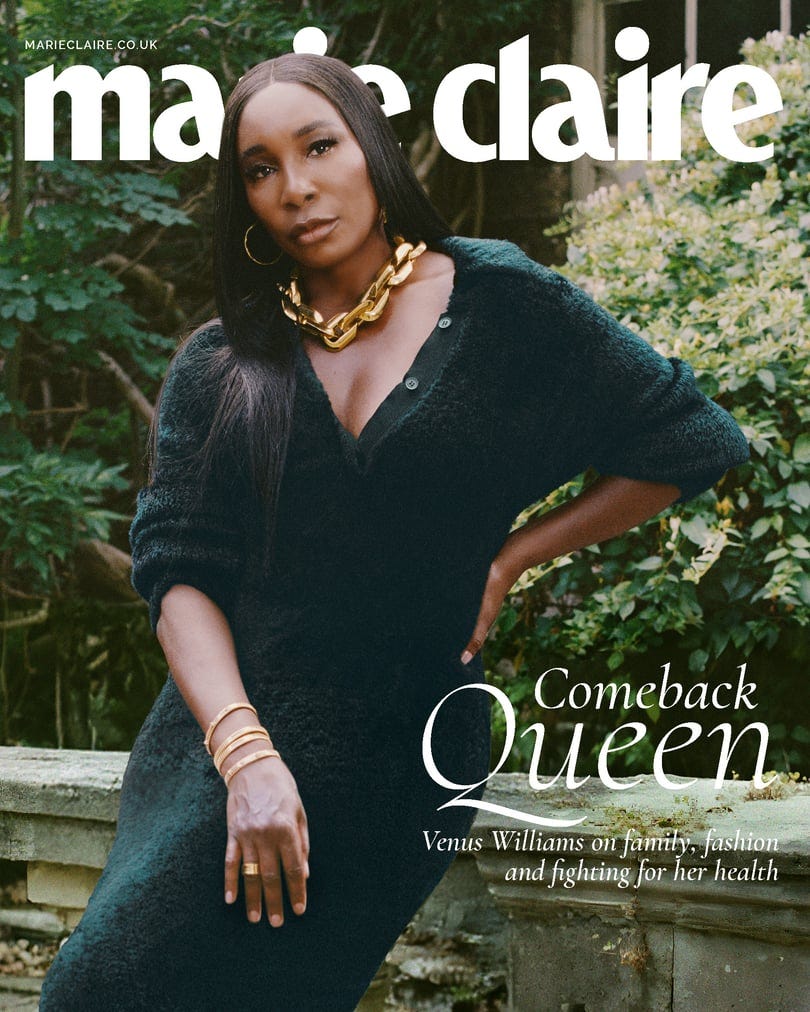When I was growing up, my Mum’s best friend wrote for Marie Claire, and I thought she was the most glamorous person. So it was a beautiful full circle moment to write my first cover story for the magazine, interviewing another icon of my childhood: Venus Williams.
Enjoy!
***
When Venus Williams strode onto the court at Wimbledon almost 30 years ago, she changed the face of tennis forever – and became one of the most decorated athletes on the planet. Since then she has advocated for women’s health, launched a design business, become an author and started a podcast with her sister. Now, she’s back on court, doing what she does best: winning and making history. I talked to the sporting superstar about family, fashion and fighting for her health
I met the Williams sisters in 1998, when all three of us were in our late teens. Witnessing Venus and Serena, their hair braided and adorned with white beads, smashing records almost as hard as their serve made a permanent impression.
“Wow,” Venus Williams says, when I remind her of our first encounter – her family coincidentally renting a house almost next door to my own. It was especially memorable because my mum had baked a cake and walked it up to the Williams’ house to congratulate them on their performances. “We’re practically family,” she laughs, before adding: “Wimbledon is very special for me. My dad had said, ‘Pick a tournament you want to win before any other.’ Wimbledon is the pinnacle of tennis; it’s one of the hardest sporting tickets to get, so I picked Wimbledon. And by the time I got there, me and Dad kind of had a pact, like, here’s the tournament you’re going to win.”
“If I have kids, I really have to raise them the way my parents raised us – just to be proud of who we were, to know our history as African Americans”
Win she did. By 2000, the year she first won Wimbledon, Williams was already widely regarded as a prodigy. She served at 100 miles per hour by the tender age of 10; turned professional at 14; and, at 18, became the first unseeded player in the Open Era to ever reach a Grand Slam final at that year’s US Open. She would go on to become the first African American woman to be ranked number one in singles by the Women’s Tennis Association. Four Olympic gold medals, seven Grand Slam singles titles, and 14 Grand Slam doubles with her sister Serena followed. Crucially, given her childhood pact with her father, she also won Wimbledon five times. Now, she’s back on court and winning games against the odds, recently beating a player 22 years her junior at the Mubadala Citi DC Open in Washington – and becoming the oldest woman to win a tour-level singles match since 2004 in the process. A blistering comeback by anyone’s standards. How conscious was she, I ask, of the change she represented, particularly for women of colour, who were almost unheard of at Wimbledon at the time? “I was thinking about this today,” she admits. “I was thinking, gosh, if I have kids, I really have to raise them the way my parents raised us – just to be proud of who we were, to know our history as African Americans. So, me being there was not necessarily even special. It was like, I am who I am. Looking back, I’m glad I had that level of oblivion.”
“Me being at Wimbledon was not necessarily even special. It was like, I am who I am. Looking back, I’m glad I had that level of oblivion”
It’s as if the concept of being ‘othered’ is alien to Williams, who says she has never sought to be like others. “If I did know that I was different,” she muses, “I don’t know if I would have cared. I’ve never wanted to walk on the path that everyone else walked. “All I could think about at the time is that I was just much better than everybody else,” she adds. “And that’s what I wanted more than anything: to be the best and to be better.” We are meeting on Zoom just days before this year’s tournament begins, me in Wimbledon, where I still live, and Williams at her home in Florida. Her enthusiasm for tennis is as undimmed as when we first met. Yet, what I (and millions of fans who watched her) didn’t realise is that while Williams was playing tennis at an extraordinary level, she was also in acute pain, suffering with undiagnosed uterine fibroids – growths on the uterus that can cause heavy menstrual bleeding and discomfort. A low point came, she says, in 2016, when she was watching Serena play the Wimbledon singles final, knowing they were up as a pair for the doubles match next.
“I don’t want to share anything in my life. I’m a very private person; that’s just my personality”
“I was so out of it. I just remember I was in so much pain, I couldn’t eat anything. I kept taking more and more Tylenol, Advil, whatever I could get. And it was not working, not working, not working,” she says emphatically. “And then all of a sudden, everybody stood up.” While Venus was in a pain-induced daze, Serena had all but won the match. “And I didn’t realise; I was just hanging in there until I was, like, wait! Is it your match point?” It was later that Williams discovered she was suffering with uterine fibroids, a common condition that medical professionals estimate can affect up to 50 per cent of women of reproductive age. It is precisely because the condition only affects women that it has not attracted the level of awareness and research it deserves, Williams says. “The most difficult thing [for] getting diagnosed is the simple fact that nobody knows about it,” she says. “If you went on the street today and asked a woman, ‘What is a uterine fibroid?’ she probably wouldn’t be able to explain. She may have heard of it, but she probably couldn’t say what your symptoms were, so there’s a lot of lack of education. “Then, if you start to go deeper... ‘What is endometriosis? What are uterine polyps? What is adenomyosis (which is also what I had)?… Nobody’s heard of that! So education is a real issue. Without education, you can’t even be an advocate for yourself,” she says.
“Whether consciously or subconsciously, sometimes you create what other people might expect from you because you are worried about what you might look like. No one should have to do that”
Williams was ultimately diagnosed and underwent surgery in 2024 – treatment she has spent 16 months recovering from. “It took me out of the game,” she states. But Williams doesn’t view her medical procedure in a negative light. “It was a great moment in my life,” she insists. “I was able to conquer something that had been getting on top of me. It was kind of this epiphany of like, ‘Wow, there’s answers to this that I wasn’t even looking for’. That was the beginning of a big change for me.” Looking back at 30 years of misdiagnosis – and being dismissed by doctors who did not take her symptoms seriously – has somewhat radicalised the tennis star into speaking out. “I don’t want to share anything in my life. I’m a very private person; that’s just my personality. But speaking up is so important: I don’t want anyone else to feel the way I did,” she says. “I’m not a lost person. I know exactly what I want, I know how to do it, I know to work real, real hard. [But] people are looking for information; I was looking for information.” Williams is not shying away from the raw details of what she went through, either. “It’s worth a little bit of discomfort in sharing uncomfortable details. Like, I was bleeding like a waterfall,” she says. It’s a big shift from the sports culture Williams grew up in; a culture that never centred on a young woman athlete’s menstrual cycles and reproductive health. Was it even taken into account, I ask?
“Nope,” Williams replies, without hesitation. “I think wellness has gotten redefined these days, right? Now people are really talking about emotional wellness and mental health – all conversations that were just super-relevant to me. As an athlete… you have to take care of all that or else you’re not gonna be able to play well. “Taking care of my mental and physical health keeps me grounded,” she adds. “Wellness has always been a top priority; real strength starts with listening to my body and giving it what it needs. I learned early on that mental health is just as important as physical fitness. A consistent routine helps me stay focused, present and balanced every day. There are no limits to excellence – it’s all in your mindset and what you’re willing to put into it, mentally, physically and emotionally.” Exploring wellness in her recent book, Strive – an eight-step guide to physical and mental wellbeing – is one of many new ventures Williams has created in recent years. “Design and wellness – this is kind of where I belong,” she says. Her love of fashion is also notorious, but she’s learned to keep that particular passion under control. “I love fashion, I really do. I used to always say I’m a recovering shopaholic, but I think I’ve finally recovered. It took forever,” she laughs. “I love watching the runway and the shows. I was watching Men’s Fashion Week from afar, watching Pharrell [Williams’ runway show for Louis Vuitton]. It’s fun, it’s fascinating, it’s inspiring. I love it.” Indeed, years after I first met her at Wimbledon, Williams obtained degrees in fashion design and business.
But less well known is her fervour for art. “I always loved the arts as a kid, even if I didn’t know it,” she says. “When I had the opportunity as an adult, I went to art school and then eventually started to explore fine art.” But it’s only now that her confidence as an artist and collector has grown. “I think art can be intimidating, right? There’s so much to learn. There’s so many time periods. There are so many artists. What’s good art? What’s bad art? But you just start,” she says. “Start reading, start learning.” Williams narrowly missed the exhibition by African American artist Noah Davis at London’s Barbican Centre recently, but says she was “so excited to have some Noah Davis swag! It’s very fun to be able to travel the world; to have access to see and experience art.” There is a sense that Williams’ love of creative fields is part of something bigger – a resistance against the way people try to put the tennis star in a box, perhaps.
“There’s been kind of a fascination about Serena and I… I don’t think a lot of people know that much about us when it really comes down to it, especially our dynamic together”
“I don’t believe in putting art in a category – or putting people in a category,” she says. “I find, whether consciously or subconsciously, sometimes you create what other people might expect from you because you are worried [about] what you might look like. No one should have to do that.” Williams, now 45, thinks about ageing, too. It’s something that’s hard to avoid as a professional athlete. “I feel young [for] my age, physically,” she says, “but my knees have always been aged 80 since I was a kid. They’ve never been on my side. I’ve had to drag them along with me.” She says she is happy with her appearance, but is open to cosmetic interventions in the future. “If I felt like I wanted to feel better about myself, and that’s what made me feel better, I would totally do it,” she says – although there are limits. “I would prefer to keep my look, you know,” she adds. “So many people are judging other people. But if it makes somebody feel good that’s all that matters.” Forever the optimist, Williams is also counting on technological advances solving our problems in health and skincare. “There’s going to be so many amazing things that happen for skincare and ageing [in the] next 20 years, so I’m excited to be a part of it,” she says enthusiastically. “And I’m so excited for what’s gonna happen with me and my hip replacement,” she laughs.
“I’ve never really played for fun. I don’t know how anybody else trains, but I train till failure”
Maybe Williams’ optimism comes from the fact she is always creating something new. She continues to expand into new ventures, including a new podcast she will present with equally iconic sister, Serena – a nod, in part, to the unceasing curiosity about the pair’s relationship over the years. Indeed, sisterhood is a theme Williams revisits throughout our chat and I ask what being part of a large family (Venus and Serena share 10 half-siblings) means to her. “Having sisters has been one of my greatest blessings. We’ve always had each other’s backs – lifting each other up, challenging each other to grow and just showing up for each other, no matter what,” she says. “Their strength, their resilience, their humour... they inspire me every single day. We’ve all always been close, but going through my tennis journey with Serena? That’s something I’ll never take for granted. I honestly can’t imagine doing it without her. Sisterhood is powerful. It’s grounding. It’s love. And I’m so grateful I get to walk through this life with them right beside me.” Is the podcast, then, a nod to the unceasing curiosity about the pair’s relationship over the years? “There’s been kind of a fascination about Serena and I, right? Because we played [against] each other so many times and people were like: ‘How do they, like, get along? Do they really like each other? They’re just faking it,” she laughs. “So we’re really excited to actually share more of ourselves. I don’t think a lot of people know that much about us when it really comes down to it, especially our dynamic together.” That dynamic was first brought to the world in fictional form through the film King Richard, in which Williams’ father was played by Will Smith (who subsequently won an Oscar for the performance). Williams says the film was “so much fun”, but she had to be talked into the idea when it was first suggested. “I was actually pretty resistant to reading the script,” she confesses. “My older sister, Isha, begged me for months and I was such a bad little sister. I was like, ‘I’m so busy and then I gotta read 100 pages?’” Was it also avoidance, I wonder, imagining how surreal it must feel to read your real-life childhood fictionalised in a movie script? “No, I was just lazy,” Williams laughs. “But when I read it, oh my God, I read so fast. And I laughed and I kind of had tears in my eyes and I was like, ‘Why do I have tears in my eyes? I know what happened!’”
“Sisterhood is powerful. It’s grounding. It’s love. And I’m so grateful I get to walk through this life with them right beside me”
Williams’ laugh is contagious. She is funny and known by those close to her for her lightness. “I’m a very silly person,” she says. “Sometimes I do come up with silly stories that I want to tell.” It’s a shame, I say, that the world hasn’t got to meet more of silly Venus. “Yeah,” she retorts, “because on the court if you are silly for one second, you know how fast a game can go? And if you fight back to win that game, there’s no moment for silliness. In real life, though, I’m never that serious.” This exchange feels like a metaphor for Williams’ life, in which so much of her personality, plans and dreams have been protected from private view, grounding her. Yet, tennis is never far away. With Williams having just returned to playing competitively, sensationally winning the women’s doubles at the Mubadala Citi DC Open in Washington earlier this month, her focus for after our interview ends is perhaps predictable: “I’m going to hit some balls,” she laughs. I have heard Williams say in previous interviews that tennis is fun. But when I ask her if she plays for pleasure, I’m met with a heavy sigh. “Well, I’ve never really played for fun,” she muses. “I don’t know how anybody else trains, but I train till failure. Your whole body and spirit is so dialled in, and after you have been on the court, you head on over to the gym and then when you get out you can’t even walk,” she explains. “So, yes, it’s fun to feel stronger and better, but it’s intense. “I’ve never trained any other way.”
This article appeared in the Women In Sport issue of Marie Claire UK, published online August 2025
EDITOR IN CHIEF: ANDREA THOMPSON PHOTOGRAPHER: SILVIA DRAZ WORDS: AFUA HIRSCH EDITOR: SUNIL MAKAN SENIOR ART EDITOR: ANA OSPINA CHIEF SUB-EDITOR: NICOLA MOYNE STYLIST: ANNA HUGHES-CHAMBERLAIN MAKE-UP ARTIST: DANIEL KOLARIC HAIR STYLIST: LAURAINE BAILEY NAIL ARTIST: CHRISTIE HUSEYIN VIDEOGRAPHER: REBECCA MUNROE PRODUCER: CLARE LAZARO SOCIAL MEDIA EDITOR: DIONNE BRIGHTON JUNIOR SOCIAL EDITOR: MAGGIE JOYNER DIGITAL OPERATOR: MORGAN SHAW ASSISTANTS: ADAAKU ONUIGBO (HAIR) EMMA SEERY AND AMY HOLDEN-BROWN (STYLING), MADISON BLAIR AND ALEX GALLOWAY (PHOTOGRAPHY)


